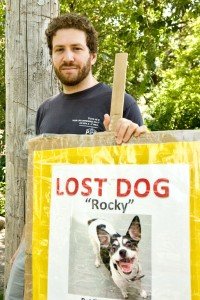Article and photos by MARGIE O’LOUGHLIN
 Dan Conybeare had just welcomed a new foster dog to his home on July 12, when the mid-sized rat terrier disappeared from the back yard. The dog’s name is Rocky, and the efforts to find him have been rocky too—a mixture of ups and downs that have surprised even Conybeare—a PhD psychologist at the VA Hospital in Minneapolis.
Dan Conybeare had just welcomed a new foster dog to his home on July 12, when the mid-sized rat terrier disappeared from the back yard. The dog’s name is Rocky, and the efforts to find him have been rocky too—a mixture of ups and downs that have surprised even Conybeare—a PhD psychologist at the VA Hospital in Minneapolis.
Conybeare has been a volunteer with Pet Haven, Minnesota’s oldest animal rescue organization, for more than a year. In that time, he’s cared for several dogs, and said, “I just really like dogs. Being a foster care provider is especially satisfying because you get to watch the process of growing, healing and changing that a rescue dog goes through, once they’re received into a stable home.”
But sometimes mistakes happen, and that’s where this story begins.
 After Rocky disappeared, Conybeare launched what residents of Longfellow could hardly fail to notice—an epic “Lost Dog” campaign with more than 150 handmade, bright green, double-sided signs placed throughout the neighborhood. Why here? Though Conybeare lives across the river in St. Paul, there had been several sightings in Longfellow, and more than one look-alike was picked up.
After Rocky disappeared, Conybeare launched what residents of Longfellow could hardly fail to notice—an epic “Lost Dog” campaign with more than 150 handmade, bright green, double-sided signs placed throughout the neighborhood. Why here? Though Conybeare lives across the river in St. Paul, there had been several sightings in Longfellow, and more than one look-alike was picked up.
Conybeare learned that there are many resources available to pet owners if they lose their dog. According to Caroline Hairfield, deputy director of Minneapolis Animal Care and Control, “If a lost dog is picked up and has a collar with current tags and a license, our return rate is 99%. We’ll try to track any identifying tags or marks, even expired licenses. Our goal is to reunite the pet with its family.”
Minneapolis is fortunate to have one centrally located animal shelter. That way, if your dog goes missing, you don’t have to make the rounds of several different shelters. The address for Minneapolis Animal Care and Control is 212 17th Ave. N., and more than 4,300 animals passed through their doors last year. “Ours is an open-admission shelter,” said Hairfield, “meaning that we take every animal that’s brought in, including wildlife. If an animal is considered treatable either medically or behaviorally, we’ll try to help.”
Why should you license your pet each year? If your licensed pet is found in Minneapolis, it will get a free ride home instead of a trip to the shelter (where there’s a $25/day impound fine). Licensed pets are three times more likely to be returned than unlicensed pets. If your pet is found injured, it will receive prompt medical attention. Your license fees help the shelter care for all lost dogs and cats, return them to their homes or find adoptive ones, and educate the public about responsible pet ownership. And last but not least, it’s the law. A one year license for a spayed/neutered cat or dog costs only $25; $10 for seniors or low-income pet owners.
Rocky was licensed and had been living in a shelter in Willmar, MN before he moved here. Unfortunately, his temperament is skittish (not unusual for a rescue dog), meaning that if chased or perhaps even approached, he’ll run.
Finding skittish dogs is the specialty of a Minneapolis-based dog rescue organization called The Retrievers. Entirely volunteer-led, they have about 10 case managers state wide. Natalie Wicker is one of them. When Conybeare sought assistance there, she told him, “Most of what we can do with The Retrievers is to help you understand the mindset of a lost dog.”
Wicker became involved with the organization when she lost her own dog last year in the dead of winter. She did everything Conybeare has done: notified Animal Care and Control and listed her missing dog on www.lostdogsmn.com, but it was the humane trapping method used by The Retrievers that brought her dog home after a week on the loose.
“Dogs revert to survival mode when they’re living in the wild,” Wicker explained. “It’s important to remember that if a dog has been gone a while, their appearance may change: collars fall off, fur becomes unkempt. Most dogs are found and returned using our old-fashioned strategy of plastering a neighborhood with signs. But if you need to approach a skittish dog, get down low to the ground, avoid eye contact and move slowly. “
The good news is that dogs are resilient and remarkably good at finding food and drinking water even when lost. Getting hit by a car poses the greatest threat. Wicker concluded, “We’ll stay with a case until the owner decides it’s time to stop—and that can be an emotional experience too.”
For more information visit www.theretrievers.org.
“I’ve gotten so much help from unexpected places,” Conybeare said, “like the three or four strangers who called and offered to walk their neighborhoods looking for Rocky. Or the local printer who ran off materials to make 30 signs for free. The staff of The Retrievers has exceeded every expectation I could have had, and my friends have been great too. I can say with a clear conscience that I’ve done the best I could. I’m going to keep trying, but I feel a deeper sense of acceptance about how this search might end.”
To report any sightings or information, please call or text Dan Conybeare at 319-270-5380.
Comments
No comments on this item Please log in to comment by clicking here